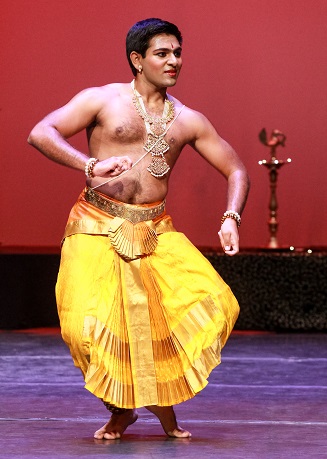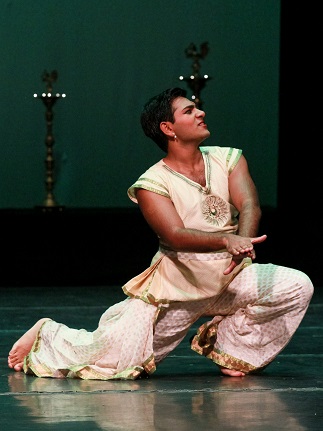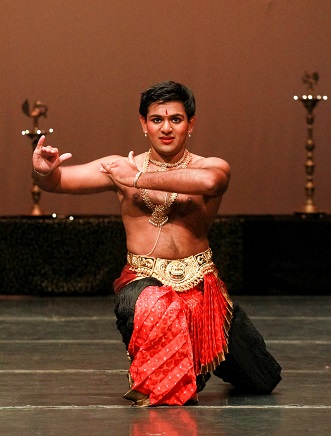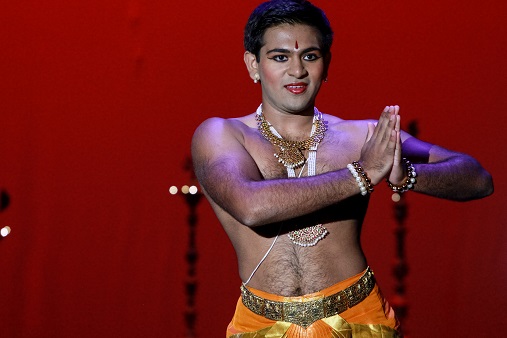Contribute
| Rangaprave​sha - Anirudh Nagesha |
Revathi Pillai and Sripriya Natarajan Moorthy
10/08/2014
Revathi Pillai
In the artistically vibrant Indian community of greater Boston, male Bharatanatyam dancers are a rarity. After a busy summer of Bharatanatyam Arangetrams by teenage girls, it was very refreshing to watch a teenage boy perform his Bharatanatyam Rangaprevesha aka Arangetram. Scintillating footwork and captivating abhinaya marked Anirudh Nagesha’s Bharatanatyam Rangapravesha at Elenor Welsh Casey Theater, Weston, MA on September 27th 2014. Anirudh is a disciple of Guru Smt. Poornima Risbud of Canton, MA. He performed to an enthusiastic audience comprising of top personalities from the music and dance fields and was greatly appreciated for his precise movements and expression. He skillfully displayed all the abhinaya aspects and maintained good control and confidence throughout the recital.
Bharatanatyam is one of the oldest classical dance forms in India. The art is said to have directly evolved from Lord Shiva, known as Lord Nataraja (King of Dance) who is the cosmic dancer. This beautiful form of dance is a combination of hand movements, facial expressions and intrinsic footwork. The word “Bharatanatyam†is derived from Bhavam for expression, Ragam for music, Talam for rhythm, and Natyam for drama. An arangetram is a dancer's first formal full-length performance of a full repertoire of dances as a soloist. To be worthy of an arangetram, a student has to master several aspects of Bharatanatyam, which takes years of dedicated practice. This performance, however, is only the beginning of a long journey in the study of dance.
Ambience of the evening was set by a beautiful Ganesha Vandana in Carukesi Raga by vocalist Smt.Neela Ramanuja. Anirudh began the performance with a Pushpanjali. The purpose of the Pushpanjali is to offer salutations and respect to Lord Nataraja, the cosmic dancer and to seek the blessings of the Guru, the musicians, and the Sabha, or audience, before embarking on this truly spiritual journey. With this invocation piece “Kolahala Narthana Ganapathiâ€, composed by shri Madurai R. Muralidharan, in Ragam Hamsadhwani and Aadi taala, Anirudh paid obeisance to Lord Ganesha, the remover of obstacles. Invocation was followed by Jathiswarm composed by Thanjavur quartet in Raagam Vasantha and Rupaka taala. Anirudh impressed the audience with his grasp of complex rhythmic patterns and his precise hand-foot movements. Anirudh convincingly introduced his abhinaya skills to the audience through the Karthikeya Sabdam “Aadum Mayil Thanai.â€
Varnam, Pièce de résistance, of the arangetram was “Bhavayami Raghuramamâ€, a soul-stirring Ragamalika set to Roopaka taala by Maharaja Swathi Thirunal. Guru Poornima Risbud’s excellence in innovative choreography was very much evident in this item and Anirudh executed it with grace and depth of feeling, moving the audience to experience rasa (aesthetics), bhava (emotion) and abhinaya. This Varnam showcased Anirudh’s exquisite dancing skills along with the maturity and discipline of an accomplished dancer.
Anirudh started the second half of his arangetram by skillfully portraying the greatness of Lord Shiva in “Bho Shambho†a krithi composed by Dayananda Saraswathi in Revathi Raaga and Aaadi taala.
This was followed by a Padam “Varava Kodu Nanageâ€, composed by Saint Kanakadasa in Ragamalika and Aadi taala on Goddess Saraswathi. In this Padam, Anirudh seek the blessing of Saraswati, whose moonlike face and sweet smile resides in the hearts of many devotees, and whose beauty and strength shine through and inspire great minds. The dancer asks Saraswati to bless him with the power of knowledge.
Anirudh continued his recital with “Kaade kaade neenu matra baradeâ€, in Raaga Vasanthi and Mishra Chapu taala. The lyrics for this item were specially written for this program by Dr. Premaleela Mallanna and music was composed by Praveen D. Rao. For an audience who is used to seeing viraha nayika depictions, through this special item, through Poornima’s beautiful choreography and Ullas Rao’s mesmerizing rendition, Anirudh transformed into a viraha nayaka. He amazed the audience by his precise movements, control, yet nuanced and subtle abhinaya.
Anirudh’s passion and joy of dancing was evident in his rendition of the dazzling Thillana, composed by Dr. Balamurali Krishna, in Kadanakutuhalam, and Aadi taala. He gracefully executed all the complex foot works and sculpturesque poses with ease and confidence.
One would marvel at his stamina as after completing the regular repertoire of an arangetram, Anirudh went on to present a unique contemporary piece, which transposed the audience to the mystical place “Panchavatiâ€. He learned this item from the renowned Kathak and Bharatanatyam dancer and teacher, Nirupama Rajendra, in Bangalore. This innovative item had a multitude of dynamic jumps, leaps and twirls in the air which he performed with grace and finesse. Anirudh’s rigorous training enabled him to execute this choreography with incredible agility. The combination of music and performance was so mesmerizing that audience stayed glued to their seats in rapt attention, applauding enthusiastically. This blissful evening was concluded with a Mangalam composed by Pandit Ravishankar and George Harrison.
Anirudh’s performance received a standing ovation from critics, artists and well-wishers. His performance was made even more enjoyable by the tasteful stage decoration, the melodious vocal music provided by Neela Ramanuja and Ullas Rao with N.G Ravi’s exceptionally energetic mridangam, Rasika Murali’s mellifluous violin accompaniment, Krishna Prasad’s enchanting flute, special effects by Pranav Dath on the rhythm pads and Guru Poornima’ s Natuvaangam. The event was beautifully emceed by the dynamic trio, Shreyas Risbud, Shachi Risbud and Partha Vaidya.
It is indeed a rare treat to see boys take up dancing and that too performing arangetram. I was very encouraged to see a boy brought up in western culture is taken up dance to the arangetram level. I hope that seeing this arangetram by a well-rounded person like Anirudh who also excels in sports, music and academics will inspire and attract more boys to dance. Congratulations to Poornima and Anirudh on a spectacular performance and best wishes for all the future endeavors. Congratulations and thank you to Pallavi and Venkatesh Nagesha for arranging their son’s very successful Bharatanatyam debut!
By Sripriya Natarajan Moorthy
Sixteen year old Anirudh Nagesha’s memorable debut solo performance during his rangapravesha on September 27, 2014 at the Eleanor Welsh Casey Theatre in Weston, MA was marked by a confidence and stage presence that belied his years. Ably guided by his guru Smt. Poornima Risbud of Rasarang School of Performing Arts, Ani demonstrated his ability in both movement and expression.
From start to finish, his performance was marked by energy, strength and expressivity. He began the program with a bold entrance for his pushpanjali in ragam Hamsadhwani and set to Adi thalam. His stamina was notable, with Ani going straight through from pushapanjali to “Kolahana Narthana Ganapathi†(composition of Sri Madurai R. Muralidharan) and then alarippu without interruption. His strength was apparent not only in the rigidity of his body and arms, but the height of his leaps, his steadiness during the faster footwork segments, the ease with which he moved from sitting to standing postures and the discipline with which his eyes moved sharply to focus on just the right spots. His face was expressive even through the pure dance sequences.
His energy and strength carried on through the next two pieces, a fast jathiswaram (composed by the Tanjore Quartet in ragam Vasantha, set to Adi thalam) and a shabdham on Lord Kartikeya (in ragamalika set to Misra Chapu thalam) which showed Ani’s ability not only to emote, but to rapidly change expressions from anger to entreaty to happiness. One could clearly see Ani’s resemblance to his mother (Smt. Pallavi Nagesha, also a disciple of Poornima Risbud and currently teacher of Rasarang’s Wayland branch) in the details of many of his expressions. The entire range of his abhinaya was showcased in his deft handling of the sancharis in the varnam, an adaptation of Swati Tirunal’s “Bhavayami Raghuramam†(in ragamalika set to Roopaka thalam) as he portrayed story after story of Lord Rama’s life. Rapidly changing between Lord Rama, Sita, Ravana, Hanuman and others, he brought out emotion not just through gestures or facial expressions, but with the way he carried his entire body, most notable in his portrayals of the building of the stone bridge to Lanka and of Sita giving the Chudamani to Hanuman in the Ashoka garden. While for the most part devotion permeated the piece, Ani’s sense of humor peeked out in his portrayal of Ravana, whether trying to lift the bow at Sita’s swayamvaram and trying unsuccessfully to get up after Rama’s fatal arrow.
Ani’s confidence and forceful movements truly brought Shiva to the stage in the opening to the second half of his program, “Bho Shambo†(a classic composition of Sri Dayananda Saraswati in ragam Revathi set to Adi thalam). In additional to the energetic movements and sharp poses, Ani’s abhinaya skills were demonstrated beautifully in the graceful movements of devotee Markandeya collecting flowers to offer to his sand lingam and the fierce attack of Yama trying to take Markandeya to his death. He continued to imbue his performance with grace and energy during both the verses in praise of Goddess Saraswathi and the fast jathis of “Varava Kodu Nanage†(composed by Sri Kanakadasa in ragamalika, set to Adi thalam). This piece in praise of the Goddess of Learning and Wisdom seemed a particularly apt choice for a young man who is passionate in his pursuit of knowledge across the spectrum—in addition to dance, he excels at his academics, at playing the double bass, at football and wrestling.
The next piece stood out in a program of many excellent selections—Poormina choreographed a specially composed piece to highlight the “viraha†mood, or angst of separation, from the Nayaka (male hero) perspective. “Kaade Neenu Matra Baradhe,†with lyrics penned by Smt. Premaleela Mallanna and music composed by Sri Praveen D. Rao, depicts Lord Krishna pining for Radha to come to him. Ani portrayed this moving piece with raw emotion and incredible maturity.
With the same energy and confidence that he had for his entrance, Ani concluded the traditional portion of his rangapravesha with a dynamic thillana (composition of Dr. Balamuralikrishna, in ragam Kadanakuduhalam, set to Adi thalam). His beaming smile made it clear that Ani was enjoying performing as much as we were enjoying watching him. Ani had one more special selection for the audience—he had learned a piece under the tutelage of Nirupama Rajendra, famed contemporary Kathak dancer. Dancing with light leaps and deep emotion to Pandit Ravishankar’s and Philip Glass’s instrumental piece “Panchavati,†Ani brought to life the magical woods where everything is captivating and where Sita becomes enamoured of the golden deer that leads to her abduction by Ravana. Ani concluded his performance with the “Bhoomi Mangalam†(composed by Pandit Ravishankar and George Harrison).
Ani’s performance was underscored by accompaniment of a highly talented orchestra: Smt. Poornima Risbud’s lively nattuvangam, Smt. Neela Ramanuja’s sweet and moving voice, Sri N. G. Ravi’s energetic mridhangam, Sri Pranav Dath’s enthusiastic electronic percussion and the beautiful tones of Sri Krishna Prasad’s flute and local young artist Kum. Rasika Murali’s singing violin. Of especial note was the vocal performance of young college student and close friend of Ani’s, Ullas Rao, who performed the specially commissioned Krishna piece. Not only was it meaningful to have a male voice supporting Ani’s portrayal of Krishna, Ullas sang the song with exquisite emotion.
It is impossible to consider Ani’s performance without also considering that he is one of few boys who pursue classical Indian dance. When studying the theory of Bharatha Natyam, we are taught about its traditionally feminine (“lasyaâ€) and masculine (“tandavaâ€) aspects. Dancers often favor one mode over the other, but Ani’s every step, gesture and expression was a pleasing blend of strength and grace. Smt. Poormina’s choreography and Ani’s execution illustrated that these two aspects do not have to oppose each other, but they can be two aspects of one movement. Ani proved to a captivated audience that he excels at dance not “in spite of†being a boy, but because of it.
You may also access this article through our web-site http://www.lokvani.com/



